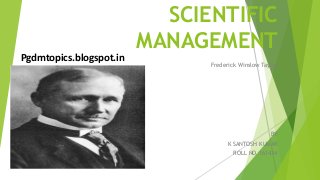Scientific management
•Download as PPTX, PDF•
1 like•761 views
pgdmtopics.blogspot.in Management of a business, industry, or economy, according to principles of efficiency derived from experiments in methods of work and production, especially from time-and-motion studies
Report
Share
Report
Share

Recommended
Recommended
More Related Content
Viewers also liked
Viewers also liked (20)
Fayol principles of management on KFC by Shivam Sharma

Fayol principles of management on KFC by Shivam Sharma
Recruitment & Selection process on Nitol Niloy Group

Recruitment & Selection process on Nitol Niloy Group
More from VJIMPGDM
More from VJIMPGDM (11)
Recently uploaded
https://app.box.com/s/z2cfx5b2yooxq1ov1wrd1dezn6af36uxBỘ LUYỆN NGHE TIẾNG ANH 8 GLOBAL SUCCESS CẢ NĂM (GỒM 12 UNITS, MỖI UNIT GỒM 3...

BỘ LUYỆN NGHE TIẾNG ANH 8 GLOBAL SUCCESS CẢ NĂM (GỒM 12 UNITS, MỖI UNIT GỒM 3...Nguyen Thanh Tu Collection
Recently uploaded (20)
Danh sách HSG Bộ môn cấp trường - Cấp THPT.pdf

Danh sách HSG Bộ môn cấp trường - Cấp THPT.pdf
Matatag-Curriculum and the 21st Century Skills Presentation.pptx

Matatag-Curriculum and the 21st Century Skills Presentation.pptx
INU_CAPSTONEDESIGN_비밀번호486_업로드용 발표자료.pdf

INU_CAPSTONEDESIGN_비밀번호486_업로드용 발표자료.pdf
Incoming and Outgoing Shipments in 2 STEPS Using Odoo 17

Incoming and Outgoing Shipments in 2 STEPS Using Odoo 17
slides CapTechTalks Webinar May 2024 Alexander Perry.pptx

slides CapTechTalks Webinar May 2024 Alexander Perry.pptx
Telling Your Story_ Simple Steps to Build Your Nonprofit's Brand Webinar.pdf

Telling Your Story_ Simple Steps to Build Your Nonprofit's Brand Webinar.pdf
BỘ LUYỆN NGHE TIẾNG ANH 8 GLOBAL SUCCESS CẢ NĂM (GỒM 12 UNITS, MỖI UNIT GỒM 3...

BỘ LUYỆN NGHE TIẾNG ANH 8 GLOBAL SUCCESS CẢ NĂM (GỒM 12 UNITS, MỖI UNIT GỒM 3...
Application of Matrices in real life. Presentation on application of matrices

Application of Matrices in real life. Presentation on application of matrices
Basic Civil Engineering notes on Transportation Engineering, Modes of Transpo...

Basic Civil Engineering notes on Transportation Engineering, Modes of Transpo...
Post Exam Fun(da) Intra UEM General Quiz 2024 - Prelims q&a.pdf

Post Exam Fun(da) Intra UEM General Quiz 2024 - Prelims q&a.pdf
Post Exam Fun(da) Intra UEM General Quiz - Finals.pdf

Post Exam Fun(da) Intra UEM General Quiz - Finals.pdf
Scientific management
- 1. SCIENTIFIC MANAGEMENT Frederick Winslow Taylor BY K SANTOSH KUMAR ROLL NO.161424 Pgdmtopics.blogspot.in
- 2. Risk comes from not knowing what you are doing…..WARREN BUFFET
- 3. Frederick Winslow Taylor (March 20, 1856 – March 21, 1915) was an American mechanical engineer who sought to improve industrial efficiency .He was one of the first management consultants . Taylor was one of the intellectual leaders of the Efficiency Movement and his ideas, broadly conceived, were highly influential in between (1890s-1920s). Taylor summed up his efficiency techniques in his 1911 book The Principles of Scientific Management.
- 4. Management of a business, industry or economy according to the principles of efficiency derived from experiments in the methods of work and production. MAIN OBJECTIVE: Improving economic efficiency , especially concentrated on labor productivity. It was one of the earliest methods to apply science to the engineering of process and to management.
- 5. Under Scientific management the initiative of the workmen( that is their hard work , their good will , their ingenuity) is obtained with absolute uniformity and in addition to the improvement on the part of the men, the managers has new burdens new duties and responsibilities never dreamed of in the past.
- 6. ‘Rule of Thumb’ means the application of traditional methods or the methods decided by the manager based on his past experience. All these methods are often untested and unscientific; they do not guarantee a specific result or outcome. In an organization, the rule of thumb can be seen as ‘the dictatorship of the manager’ which should be avoided. In this principle, Taylor states that there must be thinking before doing i.e. ‘Trail and Error Method’ or ‘Hit and Miss Method’ should be avoided, instead scientific and researched methods should be adopted for performing any activity. Taylor insists on the use of scientific techniques, which are based on cause and effect relationship so that the objectives can be achieved in a better way with the available resources, skills and budget. Thus, the emphasis is on scientific decision making based on cause and effect and the scientific measurements of the methods.
- 7. First. They develop a science for each element of a man’s work, which replaces the old rule of-thumb method. Second. They scientifically select and then train, teach, and develop the workman, whereas in the past he chose his own work and trained himself as best he could. Third. They heartily cooperate with the men so as to insure all of the work being done in accordance with the principles of the science which has been developed. Fourth. There is an almost equal division of the work and the responsibility between the management and the workmen. The management take over all work for which they are better fitted than the workmen, while in the past almost all of the work and the greater part of the responsibility were thrown upon the men.
- 8. Positive impacts of this principles: 1.Standardized results; 2 Guarantee a specific result or outcome; 3.Objectives can be achieved in a better way; 4.Better utilization of available resources, skills and budget